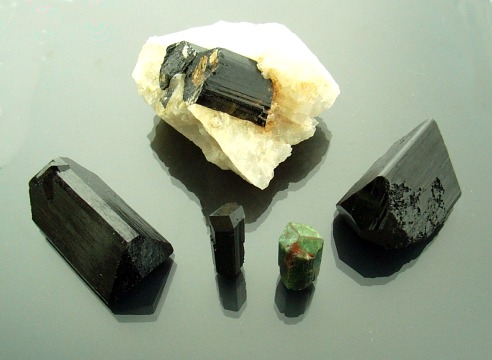 |
| 世界各地の鉄電気石とウヴァイト Schorls and Uvite |
新着標本展示室(New Crystal Specimen
Gallery)
August 2007 -
トルマリン(Tourmalines)
 |
| 世界各地の鉄電気石とウヴァイト Schorls and Uvite |
福島県石川町の鉄電気石
(Schorl from Ishikawa Town, Fukushima, Japan)
25x10mm 石英中の鉄電気石マトリクス 80x55x40mm
Schorl matrix in quartz福島県石川郡石川町塩沢
Shiozawa, Ishikawa Town, Fukushima, Japan
福島県石川町を中心とする凡そ10km四方に無数のペグマタイト鉱床が散在し1910年代から1965年頃まで10数ヶ所にて石英や長石の採掘が行われていました。採石に伴って巨大な鉄電気石や緑柱石、鉄礬柘榴石等、いずれも宝石質ではありませんが見事な結晶を産する、鉱物コレクターにとっては垂涎の土地でした。
当時、隣の栃木県宇都宮市に住む中学生であった私にとってはどうしても訪れてみたい土地でした。が、往復200kmの砂利道を唯一の交通手段である自転車で採集に出かけることは不可能でありました。
自転車では往復と採集とで16時間かかる120kmの茨城県、山の尾のペグマタイトまでが限度でした。しかし山の尾では電気石は全く採れませんでしたから、石川町の電気石結晶は夢のまた夢でしかありませんでした。
石川町も山の尾も、その他の多くの鉱物産地は現在では殆ど枯渇し、或いは採集禁止になってしまっていますが、代わりに各地で開催される鉱物フェアにて、こうした産地からの歴史的な鉱物標本を入手することが出来るようになりました。
写真の電気石も最近入手したものです。小さいながら念願の石川町産の惚れ惚れするほどの美しい結晶と、石英との結晶マトリクスです。
Around 10 square km of Ishikawa Town, Fukushima, Japan, there are numerous pegmatite veins and during 1910 to 1965, more than 10 mines operated for quartz and feldspar mining. Although not gemmmy, huge crystals of schorl, almandine garnet and beryl were recovered. Today almost all pegmatite veins of Japan, including that of ishikawa, are exhasuted and new mineral collection are impossible. Only through mineral fairs, superb specimens recovered from these quarries occasionaly encountered mainly from amateur collections. The specimens in the photo are good examples of typical schorls from renowned pegmatites of Ishikawa town.
ナミビア・エロンゴ山とブラジルの鉄電気石
(Schorls from Erongo Mtn., Namibia and from Brazil)
40x22mm 48x23mm Erongo Mtn. Namibia Rio Grande do Norte, Brazil
遠く離れたアフリカのナミビアとブラジルからそっくりの鉄電気石2点。いずれもを両端を持つほぼ完璧な結晶です。
ナミビアのエロンゴ山はアクアマリンや長石を伴う鉄電気石の産地です。
ブラジル北東部のリオ・グランデ・ド・ノルテ州は宝石産地としてはかつてはアクアマリンくらいしか知られていませんでしたが、南側のパライバ州から銅を含むパライバ・トルマリンの鉱床が伸びています。
鉄電気石は宝石質のトルマリン鉱脈の前兆として発見されるので、恐らくはパライバトルマリンの鉱脈から採れたものかも知れません。
These two schorl crystals terribly resemble each other for their shape and doubly terminated perfection, although each of them were recovered from very remote area ; one from Erongo Mtn., Namibia and another from Rio Grande do Norte, Brazil. Recently schorl from Erongo Mtn. are seen abundant with orthoclase and aquamarine crystals, while that of Rio Grande do Norte, Brazil is relatively rare. Great probably this shorl from Rio Grande do Norte might have come from famous Paraiba tourmaline veins, where schorls are often discovered as the precursor of gemmy elbaite veins.
ザンビアのウヴァイト(Uvite from Zambia)
ウヴァイト結晶 22x12mm
Uvite Crystalトラピチェ・パターンを見せるウヴァイトの薄片 8.4 - 13.4mm
Sliced uvite pieces to show trapiche patternKavungu Mine, North-Western Zambia
コンゴ共和国とアンゴラ国境に近いザンビア西北部のカヴンガ鉱山にて2004年頃からトラピチェ・エメラルドにそっくりの模様を示すトルマリンが採集されるようになりました。この鉱山は凡そ10年ほど昔にエメラルド鉱山として開発されましたが、間もなく鉱物が実はトルマリンと判明して半ば放棄されていたとのこと。その後地元の子供達が手作業で掘っては時折訪れる商人に売り渡し、一部がトラピチェ・エメラルドとして市場に流通していたようです。
詳細な分析の結果、これはほぼ純粋なウヴァイト(カルシウムーマグネシウム・トルマリン)であり、暗緑色の原因は主に0.3%ほどの酸化ヴァナジウムと0.1%前後の酸化クロムによる着色と判明しました。写真のように2cmほどのウヴァイト結晶の採集はマグネシウム成分に富む大理石の露頭地帯のラテライトの堆積の中から2,3人の子供が2時間で100個以上の結晶を採集出来るほど簡単です。しかし殆どの結晶は不透明で、薄片にしてトラピチェ模様が得られるのは1−2%です。トラピチェ模様は結晶軸に沿って含まれる主に黒鉛や赤鉄鉱の不純物です。
このウヴァイトの成因はマグネシウム成分と黒鉛片岩とを含む大理石の変成作用によるものと考えられます。またトラピチェ模様は非常に早く成長した結晶軸に沿って不純物の黒鉛が入り込んだためと考えられます。実はこのような成因はコロンビアのトラピチェ・エメラルドの成因とに極めて類似したものだったと考えられています。
Unusual green tourmalines showing trapiche pattern appeared from Zambia since 2004. The Kavunga Mine, near Angola and Democratic Republic of Congo boarder in northwestern Zambia has been known at least 10 years, but it was not significantly exploited until 2004, when commercial mining was attempted under the assumption the material was emerald. However, this activity was short-lived, and the equipment was removed when the mine investor realized that the gems were another mineral altogether. Local children continue to recover the tourmaline by hand from the various pits dug over the years., which they sell to passing traders. And a part of them were traded as trapiche emerald.
The detailed analysis revealed the mineral as pure end member of uvite(Ca-Mg tourmaline) and dark green color is attributed to about 0.3 wt% of V2O3 and about 0.1 wt% of Cr2O3 impurity. The tourmaline is fairly abundant; during two hours mine visit, a few of the children recovered more than 100 crystals. It must be noted, though, that only about 1-2% tourmaline is found as near-euhedral to euhedral crystals that are suitable for slicing or cutting thin cabochons that show the trapiche pattern. This trapiche uvite most likely formed in impure Mg-bearing marbles through metamorphic process, which is very similar to that of trapiche emeralds from Muzo,Colombia.
The black pattern is formed by growth channels that contain carbonaceous material(mainly graphite). The complex trapiche pattern is indicative of rapid growth of the tourmaline from the beginning of crystalization.
| Top | Gem Hall | New Crystal Gallery |